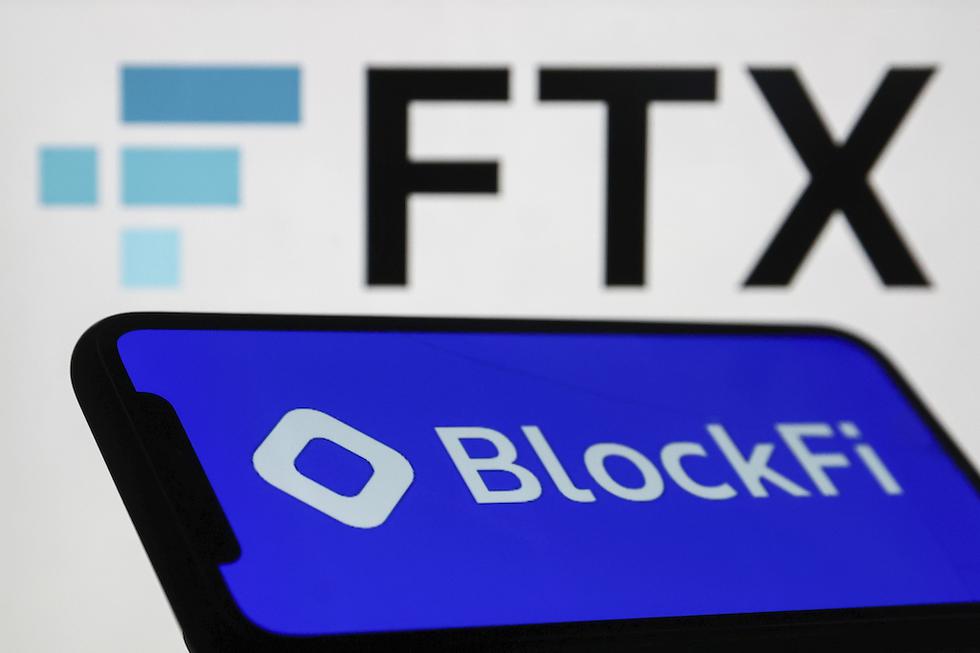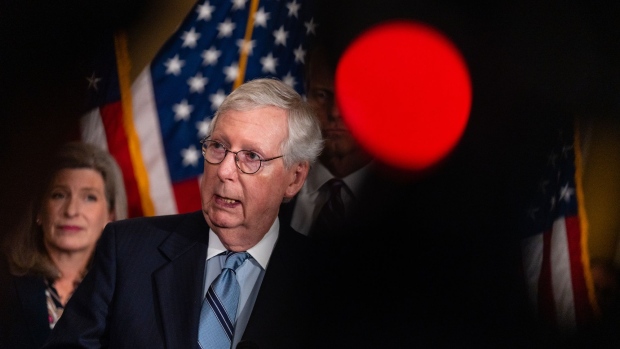Crypto lender BlockFi goes bankrupt in aftermath of FTX
, Bloomberg News
Lender BlockFi Inc. filed for bankruptcy, the latest digital-asset firm to collapse in the wake of crypto exchange FTX’s rapid downfall.
BlockFi said in a statement Monday that it will use the Chapter 11 process to “focus on recovering all obligations owed to BlockFi by its counterparties, including FTX and associated corporate entities,” adding that recoveries are likely to be delayed by FTX’s own bankruptcy. Chapter 11 bankruptcy allows a company to continue operating while working out a plan to repay creditors.
The petition, filed in New Jersey, lists BlockFi’s assets and liabilities at between US$1 billion and US$10 billion each. The company said in the statement that it had around US$257 million of cash on hand, and is starting an “internal plan to considerably reduce expenses, including labor costs.”
Citing “a lack of clarity” over the status of bankrupt FTX and Alameda Research, the Jersey City, New Jersey-based company earlier halted withdrawals and said it was exploring “all options” with outside advisers.
Following investigations into FTX by the U.S. Securities Exchange Commission and Commodity Futures Trading Commission over potential misuse of customer funds, it became unclear to BlockFi where funding for a credit line from FTX U.S. and collateral on loans to Alameda, which included Robinhood Markets Inc. stock, came from, Bloomberg News reported earlier this month. BlockFi had also been in the process of shifting over its assets over to FTX for custody, but the majority of the assets had not been moved prior to FTX’s collapse.
FTX U.S. is listed in the company’s petition as one of its top unsecured creditors, with a US$275 million loan.
The company’s largest unsecured creditor, Ankura Trust Company, is owed about US$729 million, according to the petition. Ankura acts as a trustee for BlockFi’s interest-bearing crypto accounts, according to its website.
“BlockFi’s Chapter 11 restructuring underscores significant asset contagion risks associated with the crypto ecosystem, and, potentially, deficient risk management processes,” said Monsur Hussain, senior director of Financial Institutions at Fitch Ratings. He said that that these restructing processes can be “notoriously lengthy” and noted that creditors owed money by Mt. Gox are only getting closer to be paid eight years after the Bitcoin exchange failed.
BlockFi’s bankruptcy shares similarities with that of FTX, according to Eric Snyder, partner and chairman of the bankruptcy department at law firm Wilk Auslander. He said in an interview that in both filings, the names of many of the key creditors have not been disclosed, which is unusual in a bankruptcy filing. Snyder also said that it will take a while to determine the total amount of money owed to creditors in both cases.
BlockFi was founded in 2017 by Zac Prince and Flori Marquez and in its early days had backing from influential Wall Street investors like Mike Novogratz and, later on, Valar Ventures, a Peter Thiel-backed venture fund as well as Winklevoss Capital, among others. It made waves in 2019 when it began providing interest-bearing accounts with returns paid in Bitcoin and Ether, with its program attracting millions of dollars in deposits right away.
The company grew during the pandemic years and had offices in New York, New Jersey, Singapore, Poland and Argentina, according to its website. Co-founder Prince in a March 2021 interview with Bloomberg said BlockFi was using proceeds from a US$350-million funding round to expand into new markets and fund new products. Bain Capital Ventures and Tiger Global were among the investors in the that round.
Originally valued at US$3 billion in March 2021, BlockFi looked to raise money at a reduced valuation of about US$1 billion in June. The firm also faced scrutiny from financial regulators over its interest-bearing accounts and agreed to pay US$100 million in penalties to the SEC and several US states in February. The SEC is listed on the bankruptcy filing as BlockFi’s fourth-largest creditor, with US$30 million owed to the agency.
BlockFi worked with FTX U.S. after it took an US$80 million hit from the bad debt of crypto hedge fund Three Arrows Capital, which imploded after the TerraUSD stablecoin wipeout in May.
The company had significant exposure to the empire of companies founded by former FTX Chief Executive Officer Sam Bankman-Fried. The company received a US$400 million credit line from FTX U.S. in an agreement that also gave the company the option to acquire BlockFi through a bailout orchestrated by Bankman-Fried over the summer. BlockFi also had collateralized loans to Alameda Research, the trading firm co-founded by Bankman-Fried.
The company is the latest crypto firm to seek bankruptcy amid a prolonged slump in digital asset prices. Lenders Celsius Network LLC and Voyager Digital Holdings Inc. also filed for court protection this year.
BlockFi sold about US$239 million of its own cryptocurrency and warned almost 250 workers that they would lose their jobs in the run-up to its bankruptcy filing, court papers show.
The case is BlockFi Inc., 22-19361, U.S. Bankruptcy Court for the District of New Jersey (Trenton).
BY ROBERT KUTTNER
NOVEMBER 28, 2022

JAKUB PORZYCKI/NURPHOTO VIA AP
In a recent post, I noted in passing the oddly soft coverage of the collapse of Sam Bankman-Fried in The New York Times. The Times managed to compare the woes of FTX to a bank run, to blame Bankman-Fried’s competitors for undermining his credibility, and to take his professed charitable intent at face value.
Since I wrote, the Times coverage has only gotten worse.
A piece on the interconnections between Bankman-Fried’s exchange (FTX) and the investment company he controlled (Alameda) soft-pedaled the outright illegality of his making trades with customer funds. To hear the Times tell it, “Alameda’s need for funds to run its trading business was a big reason Mr. Bankman-Fried created FTX in 2019. But the way the two entities were set up meant that trouble in one unit shook up the other as crypto prices began to drop in the spring.”
But that’s not what happened. When customers demanded their money, Fried didn’t have it, because he had been using it and losing it, illegally, for his own trades.
And this: “Alameda’s methods borrowed many aspects from traditional high finance. It was a quantitative trading firm, similar to Wall Street hedge funds that use mathematical models and data to inform decisions. It used ‘leverage’—or borrowed money—to fuel its trades and make bigger returns.”
Note the alibis, and the passive voice. The subhead tells the reader “things got out of control,” as in Nixon’s infamous “mistakes were made.” The comparable Wall Street Journal piece ran rings around the Times version, explaining the interlocks and the sheer illegality.
But the most appalling recent Times piece was their take on SEC Chair Gary Gensler, the one real hero of this whole mess. Gensler was onto the frauds and risks of crypto early, and wise to Bankman-Fried. He was repeatedly lobbied by Bankman-Fried and his allies to lighten up, but to no avail. As our colleague David Dayen wrote on Wednesday, a bipartisan group of members of the House tried to interfere with Gensler’s ongoing investigation.
But to hear the Times tell it, the problem is Gensler. According to the piece, which collects and repeats a medley of inconsistent complaints, Gensler has been both too aggressive and too soft. (“But the collapse of FTX has raised questions about Mr. Gensler’s effectiveness.”) The piece also mischaracterizes Gensler as a onetime enthusiast of crypto, when in fact he was an early skeptic.
The piece even credulously quotes one of the congressmen who sought to interfere with Gensler’s investigations: “‘Reports to my office allege he was helping SBF and FTX work on legal loopholes,’ Representative Tom Emmer, a Minnesota Republican who serves on the House Financial Services Committee, tweeted on Nov. 10 of Mr. Gensler. ‘We’re looking into this.’”
Emmer, who was just elected House majority whip, number three in the GOP leadership, led the letter that tried to get Gensler to back down, in fact. He took $11,600 from FTX employees personally for his campaign, and his work as head of the National Republican Congressional Committee, the election arm of House Republicans, was greatly buoyed by $2.75 million in donations from FTX co-CEO Ryan Salame and the company’s PAC. Emmer, who whined on Twitter about the Prospect’s piece, praised Bankman-Fried a year ago in public testimony, saying, “Sounds like you’re doing a lot to make sure there is no fraud or other manipulation.”
Any of this could have been mentioned in the Times story to give the proper context. None of it was.
If you read the bylines in these several offending pieces, you’ll see that one prime source of the charity toward Bankman-Fried and the hostility to Gensler is a young Times tech writer and cheerleader for crypto named David Yaffe-Bellany. The worst Times pieces are his, though the coverage generally has been too soft.
Yaffe-Bellany wrote the Gensler takedown. Last January, he wrote a piece called “The Rise of the Crypto Mayors,” which should be a major embarrassment to the Times. In it, he touted crypto as a smart way to pay municipal employees. He quoted one gung-ho mayor, Francis Suarez of Miami, as whacking Gensler for not getting with the program.
Yaffe-Bellany is just one writer on a large business staff. Like a lot of tech enthusiasts, he’s just a few years out of school. He was managing editor of the Yale Daily News, and graduated in 2018.
But writers presumably have editors. Why wasn’t some adult at the Times paying attention to the spin?
FTX Donated $1 Million to a Super-PAC Linked to Mitch McConnell in October
, Bloomberg News

(Bloomberg) -- FTX US, a part of Sam Bankman-Fried’s crypto empire that catered to American customers, contributed to a super-PAC fighting for control of the Senate in the midterm election just days before the company’s collapse.
The Senate Leadership Fund, which is aligned with Senate Republican Leader Mitch McConnell and was the top spender in the 2022 midterms, received the $1 million donation on Oct. 27, according to its most recent filing with the Federal Election Commission. Only a couple of weeks later, more than a 100 FTX-related companies, including the US arm, filed for bankruptcy, and Bankman-Fried resigned as head of the corporate group.
The contributor listed on the FEC donation report is West Realm Shires Services Inc. and FTX US is its commercial name.
The Senate Leadership Fund did not immediately respond to a request for comment. The super-PAC spent $239 million in the midterms on behalf of Republican candidates, according to OpenSecrets, which tracks money in politics.
While several members of Congress, including Illinois Senator Richard Durbin, a Democrat, and Republican Representative Kevin Hern of Oklahoma have said they would return donations from FTX executives or give the money to charities, there isn’t a requirement in election law for committees to return donations to companies that go bankrupt.
FTX US also gave $750,000 to the Congressional Leadership Fund and $150,000 to the American Patriots PAC, both of which supported House Republican candidates. It gave $100,000 to the Alabama Conservatives Fund, which backed Republican Katie Britt’s successful run for the state’s open Senate seat.
Individual executives at the broader FTX company have given far more money. Bankman-Fried emerged as major donor to Democratic candidates leading up to the Nov. 8 midterm elections, donating most of the $39.4 million that he gave to them, FEC records show. One of his top lieutenants, Ryan Salame, gave $23.6 million -- mostly to Republicans.
As Congress weighs bills that would regulate digital currencies, the crypto industry became a major player in the 2022 election cycle, with industry players donating $84.1 million through mid-October. But most of that amount, some 84%, came from Bankman-Fried and other FTX executives. Committees in the House and Senate have scheduled hearings next month on the firm’s collapse, with Bankman-Fried as a potential witness.
--With assistance from Allyson Versprille.
©2022 Bloomberg L.P.
No comments:
Post a Comment